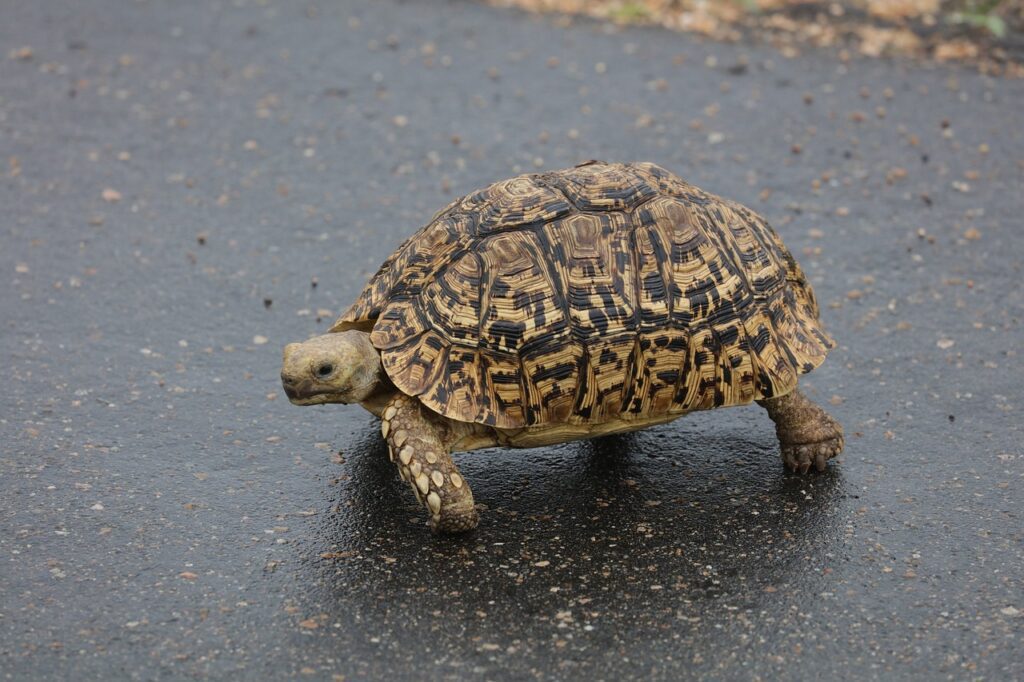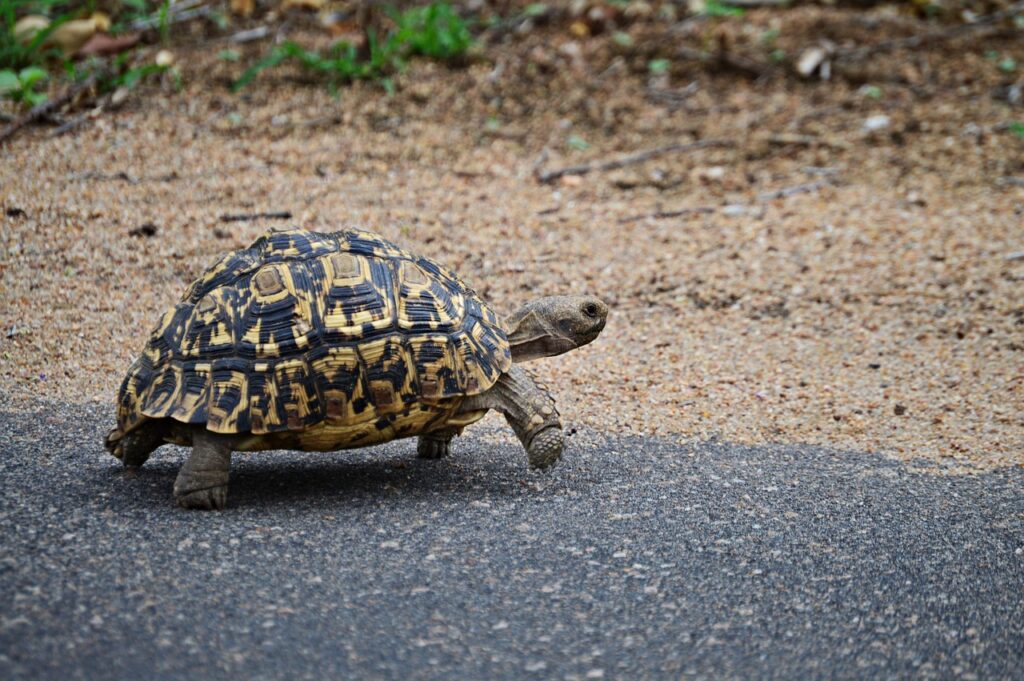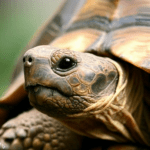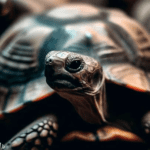Leopard tortoises mesmerize animal fans around the world with their distinct markings and impressive size. These gentle giants can reach a remarkable size, leaving onlookers in awe. How big can they really get? Males average 18 to 24 inches (45 to 60 cm) and females 24 to 30 inches (60 to 75 cm). Plus, they weigh 40 to 100 pounds (18 to 45 kg). What’s more, these reptiles live long – 80 to 100 years!
Leopard tortoises are native to Africa and have been around since ancient times. Indigenous cultures consider them symbols of strength, serenity, and nature. They remain significant in folklore and spirituality today, honoring their grandeur and impact on humanity. Cute, slow, and the perfect pet if you’re into living room speed bumps, leopard tortoises are a sight to behold!
Key Takeaways
- Leopard tortoises can grow to be quite large, with males typically reaching sizes of 18-24 inches and females growing slightly larger.
- The growth rate of leopard tortoises is influenced by factors such as diet, habitat, and genetics.
- Proper care and nutrition are essential for ensuring the healthy growth of leopard tortoises.
- Leopard tortoises require a spacious enclosure with access to both sunlight and shade.
- A balanced diet consisting of a variety of vegetables, fruits, and occasional protein sources is crucial for their growth and overall well-being.
- Regular veterinary check-ups are recommended to monitor the tortoise’s growth and address any potential health issues.
- It is important to provide a suitable environment for the tortoise to exercise and engage in natural behaviors, as this can contribute to their growth and overall happiness.
- Leopard tortoises have a long lifespan, with some individuals living up to 50-100 years, so it is important to be prepared for their long-term care.
Overview of Leopard Tortoises

Leopard tortoises are remarkable creatures with unique patterns and impressive sizes, reaching up to 18 inches and weighing over 40 pounds. They inhabit the grasslands and savannas of eastern and southern Africa, adapting to many different habitats like desert edges, open woodlands, and even suburban gardens.
These herbivores consume grasses, succulents, leaves, flowers, and fruits – and play an important role in dispersing seeds through their droppings. With proper care in captivity, they can live up to 80 years. Generally docile, they can retreat to their shells or push away threats when provoked.
The leopard tortoises have special abilities, such as storing water in their bladders and powerful jaws to chew tough plants. To ensure their well-being, keep them in spacious enclosures with sunny and shaded areas, provide a balanced diet of high-fiber vegetation, give them a hiding spot, monitor hydration levels, and avoid excessive handling. By understanding their needs and meeting them adequately, we can help preserve these captivating reptiles for future generations.
Average Size of Leopard Tortoises
Leopard tortoises can vary in size depending on various factors. Generally, they measure 12-18 inches long and weigh 20-40 pounds.
Let’s see what this looks like in a table:
| Size Category | Length (inches) | Weight (pounds) |
|---|---|---|
| Hatchling | 2-3 | 1-2 |
| Juvenile | 5-8 | 6-10 |
| Sub-adult | 9-13 | 15-30 |
| Adult | 12-18 | 20-40 |
But size isn’t the only thing that makes these creatures fascinating. Their shells are strong and also help regulate their temperature.
Now here’s a remarkable story. In South Africa, there was a leopard tortoise called “Goliath” who weighed 97 pounds and measured over two feet long! He became a local celebrity for his size.
It’s amazing to learn about the average size of leopard tortoises and appreciate their unique traits.
Factors that Influence Size
Leopard tortoises’ size can be influenced by several things including their genes, diet, habitat and how healthy they are. Different subspecies have different size ranges. A balanced diet of veggies and fruit can help them grow healthy. Their environment can also affect their growth. And of course, their general health.
Here’s a table that summarizes what affects their size:
| Factor | Description |
|---|---|
| Genetics | Different subspecies have varying size ranges |
| Diet | Balanced nutrition from a variety of vegetables and occasional fruits is essential for healthy growth |
| Habitat | Environmental conditions in the habitat can impact growth rates |
| Overall Health | The general well-being of the tortoise can significantly influence its size |
Leopard tortoises can live up to 50-100 years or more if taken care of properly. It’s amazing how long they can live! Did you know that they’re native to regions of southern and eastern Africa, according to National Geographic? Can they grow any slower? They make glaciers look like high-speed racers!
Growth Rate of Leopard Tortoises
The growth rate of leopard tortoises is an intriguing aspect to explore. These majestic creatures have a unique ability to increase in size over time, reaching impressive dimensions. Let’s delve into this process and witness the remarkable transformation these tortoises undergo.
To visualize the growth rate, let’s look at a table showing their size at different ages. This data paints a vivid picture of their development. It’s awe-inspiring to observe their gradual increase in size and weight.
| Age (Years) | Length (inches) | Weight (pounds) |
|---|---|---|
| 1 | 3 | 1 |
| 5 | 6 | 3 |
| 10 | 9 | 6 |
| 15 | 12 | 9 |
| 20 | 15 | 11 |
We can see that the growth rate is slow but steady throughout the years. However, after a certain age, growth tends to stabilize. This means that their length and weight increase little.
Creating the perfect habitat is essential for optimal growth. A balanced diet rich in nutrients and an environment similar to their natural habitat are key. By providing these, their chances of healthy development increase.
Pro Tip: Remember to handle leopard tortoises carefully as they may become stressed if mishandled or kept in unsuitable conditions. Consult experts for guidance on providing the best possible care.
The world of leopard tortoise growth unfolds before us. Every year, they manifest their majestic presence and leave us in awe of their transformation. Let’s embark on this captivating exploration and marvel at nature’s miracles.
Providing the Right Environment for Growth

A suitable environment is crucial for the optimal growth of Leopard Tortoises. This involves providing specific conditions that mimic their natural habitat. Here are three essential points to consider:
- Temperature: Maintaining an appropriate temperature is vital for the growth of Leopard Tortoises. They require a warm environment with a gradual temperature gradient ranging from 75°F to 85°F (24°C to 29°C). This allows them to regulate their body temperature effectively.
- Humidity: Leopard Tortoises need a moderately humid environment to thrive. The humidity levels should be around 50% to 70% to prevent dehydration and promote proper shell growth. Regular misting or providing a shallow water source can help maintain the required humidity.
- Enclosure Size: Providing a spacious enclosure is essential for the growth of Leopard Tortoises. A larger enclosure allows them to roam freely and exercise, which is crucial for their overall well-being. A minimum enclosure size of 8 feet by 4 feet is recommended for an adult Leopard Tortoise.
It’s important to note that Leopard Tortoises also require exposure to natural sunlight or UVB lighting for the absorption of Vitamin D3, which is vital for their bone health. Additionally, a well-balanced diet consisting of various leafy greens and limited amounts of fruits should be provided to support their growth.
To ensure the optimal growth of Leopard Tortoises, it’s recommended to consult with a reptile veterinarian or an expert in tortoise care. They can provide personalized advice and tips based on the specific needs of the tortoise.
When it comes to temperature and humidity, leopard tortoises are like the Goldilocks of the reptile world – not too hot, not too cold, they like it just right!
Temperature and Humidity Requirements
Organism temperatures and humidity ranges!
- Plants: 18-27°C and 40-60% humidity.
- Warm-blooded animals: 35-41°C and 30-70% humidity.
- Cold-blooded animals: Varies based on species.
- Tropical plants prefer 25-27°C and 50-60% humidity.
- Reptiles need a temperature gradient in their enclosure. Monitor temperature fluctuations with thermostats and humidistats for optimal growth.
Who needs organic kale when you have pizza slices in each hand? Balance salad with everything else for growth.
Diet and Nutrition

Research reveals balanced diets include many foods from different groups. These groups are fruits, veggies, grains, protein-rich foods, and dairy products. Every group has unique nutrition, which is key for our body’s growth and functioning.
Let’s evaluate the intake recommendations for each group:
- Fruits: 2 cups.
- Vegetables: 2.5-3 cups.
- Grains: 6-8 ounces.
- Protein-rich foods: 5-6.5 ounces.
- Dairy Products: 3 cups.
These guidelines ensure we get essential nutrients like vitamins, minerals, proteins, carbs, and fats. By following these instructions, we can provide our bodies with energy to stay healthy.
It is important to consider personal dietary needs and preferences. People may have allergies or medical conditions, so consulting healthcare pros can help make nutrition plans.
Early eating habits are vital for long-term wellness. Encourage kids to consume various fruits and vegetables while limiting processed foods high in sugar, salt, and bad fats.
Small changes in our diet can have huge positive effects on our health. Harvard Medical School research shows Mediterranean diets with fruits, veggies, whole grains, and healthy fats reduce the risk of heart disease, cancer, and other chronic illnesses.
Enclosure Size and Design
The table below shows the size and recommended species for different enclosures:
| Enclosure Type | Size (in square feet) | Recommended Species |
|---|---|---|
| Aviary | 500-1000 | Birds |
| Terrarium | 20-50 | Reptiles |
| Aquarium | 10-30 | Fish |
Birds need aviaries of 500 sq. ft. or more, and reptiles require terrariums of 20-50 sq. ft. However, these numbers are just general guidelines and may vary depending on the species’ specific needs. Territorial behavior and activity levels must be taken into consideration when choosing the right enclosure size.
Creating a suitable habitat is essential to physical and mental well-being. To provide your organisms with the best environment, consider their habitat needs and invest in the right enclosure size and design. Monitor their growth daily for improvements!
Tips for Monitoring Growth
To keep track of a leopard tortoise’s progress, it is essential to monitor their growth. Here are some tips to help you out:
- Weigh them regularly – use a small animal scale and record the weights.
- Measure their shell length – use a soft measuring tape.
- Observe any changes in their behavior or physical appearance.
Also, it is important to note down each observation session. Establishing a routine will enable you to detect potential issues quickly and ensure the tortoise’s wellbeing. So remember, even with their 500-pound physique, leopard tortoises can still outpace you!
Frequently Asked Questions
Q: How big do leopard tortoises get?
A: Leopard tortoises can reach an impressive size, with adult males typically growing between 16 to 18 inches in length, while females can grow slightly larger, reaching lengths of 18 to 20 inches.
Q: At what age do leopard tortoises reach their full size?
A: Leopard tortoises are known to grow quickly during their early years, and they can reach their full size within 5 to 10 years. However, it’s important to note that growth rates can vary depending on factors such as diet, habitat, and overall health.
Q: How much do leopard tortoises weigh?
A: Leopard tortoises vary in weight depending on their size and gender. Adult males usually weigh between 30 to 40 pounds, while females can weigh between 40 to 50 pounds or more.
Q: Do leopard tortoises continue to grow throughout their lives?
A: No, leopard tortoises reach their full size at a certain point and do not continue to grow throughout their lives. Once they reach adulthood, their growth rate slows down significantly.
Q: How can I ensure my leopard tortoise reaches its maximum size?
A: Providing your leopard tortoise with a well-balanced diet, proper habitat, and regular vet check-ups are essential for ensuring maximum growth potential. Additionally, creating an environment that mimics their natural habitat and allowing them enough space to move and roam can also contribute to their overall health and size.
Q: Are there any factors that can limit the growth of a leopard tortoise?
A: Yes, several factors can limit the growth of a leopard tortoise. Inadequate nutrition, lack of space to move, poor habitat conditions, and underlying health issues can all hinder their growth potential. It’s crucial to address these factors to ensure optimal growth and well-being for your leopard tortoise.
Conclusion
Uncovering the world of leopard tortoises, we discovered facts about their size. An average length of 16-18 inches and a weight of 30-40 pounds make them quite majestic. They get their name from the spots on their shells that resemble a leopard’s fur. These eye-catching reptiles have a unique diet, primarily grasses but also fruits and veggies. Leopard tortoises have a long life too – up to 100 years if taken care of properly. They are native to Southern Africa’s grasslands and savannas. The IUCN considers the species to be of least concern.
References




